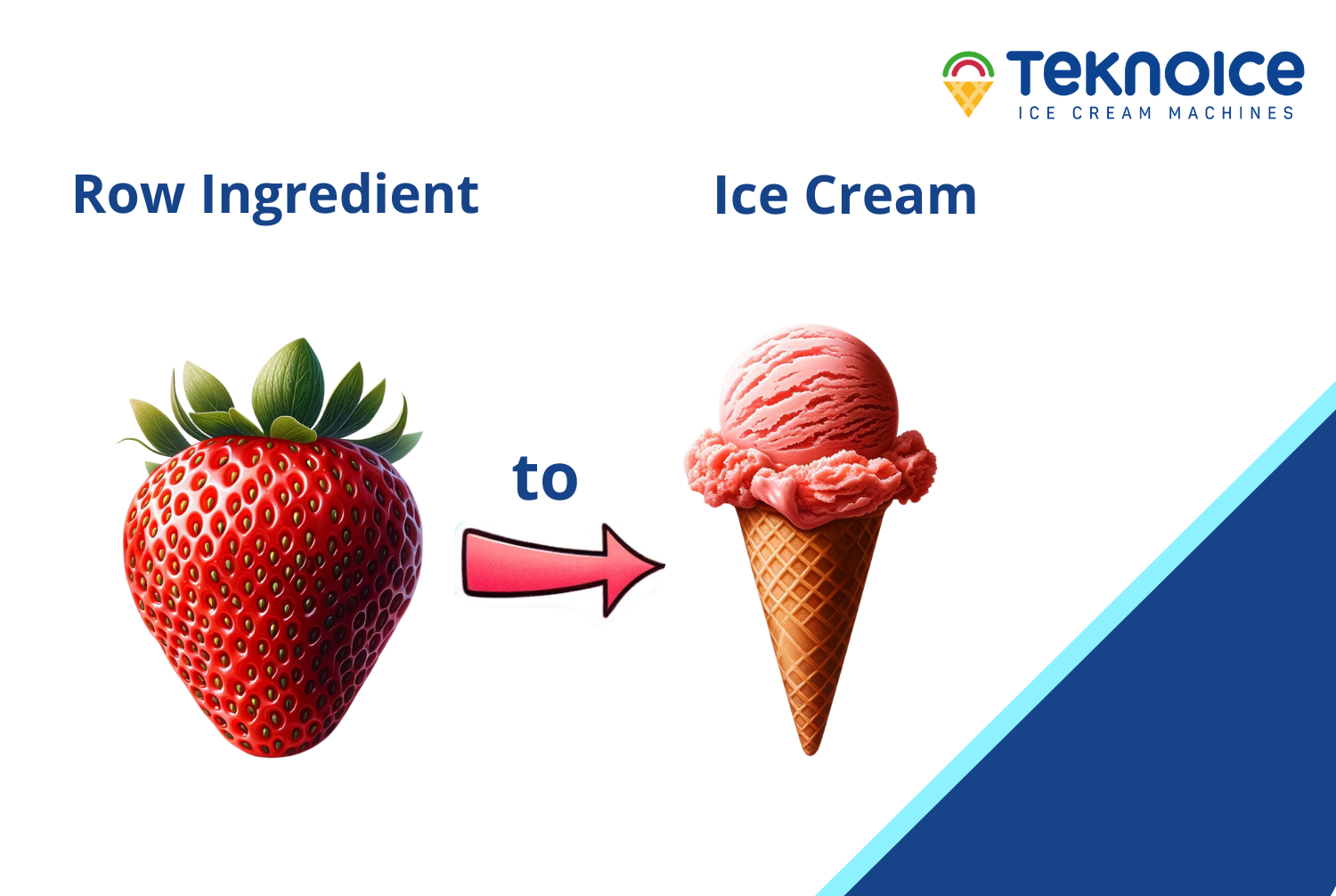Subscribe to our newsletter
Keep updated with our latest innovations.
How to make commercial ice cream: ice cream production from pasteurization to final packaging
- 19/12/2023
- Posted by: Debora Bolis
- Category: BLOG

Here’s a question you might have often asked yourself: How does industrial ice cream production work? Find out in this delicious journey through the world of ice cream production! Explore how specialized machinery transforms basic ingredients into everyone’s beloved frozen delights. It is a fascinating, flavor-filled adventure from start to finish.
How ice cream is made in a factory: the ice cream production process
Ice cream production occurs in several steps, each requiring specialized machinery. Teknoice is the best partner for the supply of ice cream production machinery: it offers solutions perfect for creating an efficient and fast commercial ice cream production; plus, every piece of equipment can be fully customized to match every customer’s needs.
Let’s review what machines are needed and at what stage of the ice cream production they are used.
Mixing the Ingredients
This is the first step in the ice cream production process: the main ingredients include milk, sugar, stabilizers, emulsifiers, and flavors. Getting the right proportion of these ingredients is crucial to achieve the desired consistency and taste. This first step will establish the ice cream’s quality, flavor, and texture.
The machines needed for this step are scales and ingredient-measuring tools.
Pasteurization
This is the second step in the ice cream production process: once the ingredients are mixed, the mixture is heatedto eliminate any harmful bacteria, ensuring food safety since, typically, pasteurization occurs at temperatures between 700 C and 850 C. In addition to eradicating potential pathogens, pasteurization also improves the ice cream’s structure and creaminess, which is important to make ice cream enjoyable for everyone.
The machines needed for this step are pasteurizing plants. Teknoice offers a fantastic range of these plants, which are fully customizable.
Homogenization
At this point, the ice cream mix undergoes homogenization, reducing the particle size to obtain a smoother and creamier consistency. It breaks down fat molecules and ensures they are evenly distributed throughout the mixture. The homogenization process is critical to preventing the formation of large ice crystals during freezing. In turn, it enhances the ice cream’s stability and mouthfeel.
The machines needed for this step are homogenization plants.
Cooling and Maturation
This combined step is the fourth in the ice cream production process: after homogenization, the mix is allowed to rest, which fully integrates the ingredients to develop the desired flavor. Maturation time can vary from a few hours to several hours, depending on the ice cream type. The flavors meld together in this period, leading to a more stable structure and enhanced taste. Of course, cooling the mixture before freezing is crucial to improve the final quality of the ice cream; thus, it is an essential part of how ice cream is made in a factory and not to be overlooked. These steps are made using refrigerators and maturation tanks.
Freezing and Churning
Then, the cooled mix is introduced into a freezer, where it is frozen and churned simultaneously. The churning process incorporates air into the mix, giving the ice cream its signature creamy texture. This step is essential for transforming the liquid mixture into a semi-solid, airy structure that looks much like the ice cream we all know.
The machines needed for this step are churning machines and continuous freezers, which, luckily, are supplied by Teknoice and offer excellent features and customization options.
Adding the Ingredients
At this point, we have almost reached the end of the ice cream production: during the freezing process, additional ingredients like chocolate, fruit, or nuts can be added to enrich the ice cream with various flavors. This step allows the creation of a myriad of ice cream types.
The machines needed for this step depend on the variety of ice cream one wants to make, and they can range from fruit dispensers to ripple pumps. To know which ones to choose, check out this helpful guide by Teknoice.
Hardening and Extrusion
This is the last step of the ice cream production before packaging.
After churning, the ice cream may still be too soft for immediate packaging. The product is often transferred to a colder freezer than the continuous freezer to harden it. This hardening process further solidifies the ice cream, lowering its temperature and ensuring it reaches the ideal consistency for packaging.
Once the ice cream achieves the desired consistency through hardening, it can be extruded from the freezer. Extrusion pushes the ice cream out of the machine, typically through specific nozzles or openings, shaping the final product. Ice cream can be extruded into cones, cups, or tubs.
The quality of the machines needed for this step is of critical importance, and excellent examples are the ones offered by Teknoice: our extrusion and hardening lines are closely followed by our R&D team to ensure that quality is maintained at every stage.
Packaging
Finally, this is the last step in the ice cream production process: the ice cream is packaged into appropriate containers, which vary in size and shape depending on the style of ice cream desired. Automated packaging lines boost the efficiency of this process, ensuring the ice cream is ready for distribution and sale.
The machines needed for this step are several and range from automatic packaging lines and filling machines to wrapping machines, all of which are available at Teknoice.
Teknoice supplies efficient machinery for every step of the ice cream industrial production
And now, if you wish to explore further how to choose the efficient machinery you may need for ice cream production, all you have to do is contact Teknoice today. We can help you choose the perfect machine for your needs and define the best layout of your ice cream production plant!